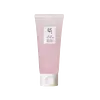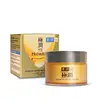What's inside
What's inside
 Key Ingredients
Key Ingredients

 Benefits
Benefits

 Concerns
Concerns

 Ingredients Side-by-side
Ingredients Side-by-side

Water
Skin ConditioningButylene Glycol
HumectantGlycerin
Humectant1,2-Hexanediol
Skin ConditioningMethyl Trimethicone
Skin ConditioningPhaseolus Angularis Seed Extract
AntioxidantAcrylates/C10-30 Alkyl Acrylate Crosspolymer
Emulsion StabilisingTromethamine
BufferingGlyceryl Glucoside
HumectantC12-14 Alketh-12
EmulsifyingMaltodextrin
AbsorbentAmmonium Acryloyldimethyltaurate/Vp Copolymer
Dimethicone/Vinyl Dimethicone Crosspolymer
Skin ConditioningDimethicone Crosspolymer
Emulsion StabilisingEthylhexylglycerin
Skin ConditioningBetaine
HumectantPanthenol
Skin ConditioningAllantoin
Skin ConditioningDipotassium Glycyrrhizate
HumectantPolyquaternium-51
Skin ConditioningXanthan Gum
EmulsifyingDisodium EDTA
Glyceryl Acrylate/Acrylic Acid Copolymer
HumectantDioscorea Japonica Root Extract
Skin ConditioningGlucose
HumectantSodium Citrate
BufferingBeta-Glucan
Skin ConditioningHydrolyzed Corn Starch
HumectantCitric Acid
BufferingSucrose
HumectantMagnesium Ascorbyl Phosphate
AntioxidantCaprylyl Glycol
EmollientHelianthus Annuus Seed Oil
EmollientTocopherol
AntioxidantCyanocobalamin
Skin ConditioningGlycine
BufferingSerine
MaskingGlutamic Acid
HumectantAspartic Acid
MaskingLeucine
Skin ConditioningAcetyl Hexapeptide-8
HumectantAlanine
MaskingLysine
Skin ConditioningArginine
MaskingTyrosine
MaskingPhenylalanine
MaskingProline
Skin ConditioningThreonine
Valine
MaskingIsoleucine
Skin ConditioningHistidine
HumectantCysteine
AntioxidantMethionine
Skin ConditioningPhosphoric Acid
BufferingAscorbic Acid
AntioxidantSh-Oligopeptide-1
Skin ConditioningSh-Oligopeptide-2
Skin ConditioningSh-Polypeptide-1
Skin ConditioningWater, Butylene Glycol, Glycerin, 1,2-Hexanediol, Methyl Trimethicone, Phaseolus Angularis Seed Extract, Acrylates/C10-30 Alkyl Acrylate Crosspolymer, Tromethamine, Glyceryl Glucoside, C12-14 Alketh-12, Maltodextrin, Ammonium Acryloyldimethyltaurate/Vp Copolymer, Dimethicone/Vinyl Dimethicone Crosspolymer, Dimethicone Crosspolymer, Ethylhexylglycerin, Betaine, Panthenol, Allantoin, Dipotassium Glycyrrhizate, Polyquaternium-51, Xanthan Gum, Disodium EDTA, Glyceryl Acrylate/Acrylic Acid Copolymer, Dioscorea Japonica Root Extract, Glucose, Sodium Citrate, Beta-Glucan, Hydrolyzed Corn Starch, Citric Acid, Sucrose, Magnesium Ascorbyl Phosphate, Caprylyl Glycol, Helianthus Annuus Seed Oil, Tocopherol, Cyanocobalamin, Glycine, Serine, Glutamic Acid, Aspartic Acid, Leucine, Acetyl Hexapeptide-8, Alanine, Lysine, Arginine, Tyrosine, Phenylalanine, Proline, Threonine, Valine, Isoleucine, Histidine, Cysteine, Methionine, Phosphoric Acid, Ascorbic Acid, Sh-Oligopeptide-1, Sh-Oligopeptide-2, Sh-Polypeptide-1
Water
Skin ConditioningGlycerin
HumectantHydrogenated Polyisobutene
EmollientButylene Glycol
HumectantDipropylene Glycol
HumectantDimethicone
EmollientBehenyl Alcohol
EmollientTribehenin PEG-20 Esters
EmollientButyrospermum Parkii Butter
Skin ConditioningHydrogenated Castor Oil Dimer Dilinoleate
Skin ConditioningPentylene Glycol
Skin ConditioningPanthenol
Skin ConditioningNiacinamide
SmoothingLimnanthes Alba Seed Oil
Skin ConditioningHydroxyacetophenone
AntioxidantBetaine
HumectantOenothera Biennis Oil
EmollientHydroxyethyl Acrylate/Sodium Acryloyldimethyl Taurate Copolymer
Emulsion StabilisingCaprylic/Capric Triglyceride
MaskingTitanium Dioxide
Cosmetic ColorantSqualane
EmollientTocopherol
AntioxidantXanthan Gum
EmulsifyingSodium Stearoyl Glutamate
CleansingDipotassium Glycyrrhizate
HumectantHydrogenated Phosphatidylcholine
EmulsifyingDisodium EDTA
Ubiquinone
AntioxidantPolyhydroxystearic Acid
EmulsifyingAluminum Stearate
Cosmetic ColorantBisabolol
MaskingPolysorbate 60
EmulsifyingAlumina
AbrasiveHippophae Rhamnoides Oil
EmollientEuterpe Oleracea Fruit Oil
Skin ConditioningRubus Idaeus Seed Oil
EmollientOxycoccus Palustris Seed Oil
AntioxidantCalophyllum Inophyllum Seed Oil
AntimicrobialSodium Hyaluronate
HumectantHydrolyzed Sodium Hyaluronate
Skin ConditioningCarnosine
Skin ConditioningSorbitan Isostearate
EmulsifyingLavandula Angustifolia Oil
MaskingCamellia Sinensis Leaf Extract
AntimicrobialSodium Acetylated Hyaluronate
HumectantSodium Benzoate
MaskingLactic Acid
BufferingHydrolyzed Algin
Potassium Sorbate
PreservativeZingiber Officinale Root Extract
MaskingPhenoxyethanol
PreservativeHelianthus Annuus Seed Oil
EmollientSodium Hyaluronate Crosspolymer
HumectantRosmarinus Officinalis Leaf Extract
AntimicrobialCollagen
MoisturisingPalmitoyl Tripeptide-5
Skin ConditioningPalmitoyl Hexapeptide-12
Skin ConditioningWater, Glycerin, Hydrogenated Polyisobutene, Butylene Glycol, Dipropylene Glycol, Dimethicone, Behenyl Alcohol, Tribehenin PEG-20 Esters, Butyrospermum Parkii Butter, Hydrogenated Castor Oil Dimer Dilinoleate, Pentylene Glycol, Panthenol, Niacinamide, Limnanthes Alba Seed Oil, Hydroxyacetophenone, Betaine, Oenothera Biennis Oil, Hydroxyethyl Acrylate/Sodium Acryloyldimethyl Taurate Copolymer, Caprylic/Capric Triglyceride, Titanium Dioxide, Squalane, Tocopherol, Xanthan Gum, Sodium Stearoyl Glutamate, Dipotassium Glycyrrhizate, Hydrogenated Phosphatidylcholine, Disodium EDTA, Ubiquinone, Polyhydroxystearic Acid, Aluminum Stearate, Bisabolol, Polysorbate 60, Alumina, Hippophae Rhamnoides Oil, Euterpe Oleracea Fruit Oil, Rubus Idaeus Seed Oil, Oxycoccus Palustris Seed Oil, Calophyllum Inophyllum Seed Oil, Sodium Hyaluronate, Hydrolyzed Sodium Hyaluronate, Carnosine, Sorbitan Isostearate, Lavandula Angustifolia Oil, Camellia Sinensis Leaf Extract, Sodium Acetylated Hyaluronate, Sodium Benzoate, Lactic Acid, Hydrolyzed Algin, Potassium Sorbate, Zingiber Officinale Root Extract, Phenoxyethanol, Helianthus Annuus Seed Oil, Sodium Hyaluronate Crosspolymer, Rosmarinus Officinalis Leaf Extract, Collagen, Palmitoyl Tripeptide-5, Palmitoyl Hexapeptide-12
 Reviews
Reviews

Ingredients Explained
These ingredients are found in both products.
Ingredients higher up in an ingredient list are typically present in a larger amount.
Betaine is a common humectant (a substance that promotes retention of moisture). It's known to be gentle on the skin and can help balance hydration.
This ingredient is best for improving hydration and soothing irritated skin. Studies also show it helps even out skin tone.
Fun fact: Betaine is naturally created in the skin and body. The kind found within cosmetic products can be either plant-derived or synthetic.
Another name for betaine is trimethylglycine.
Learn more about BetaineButylene Glycol (or BG) is used within cosmetic products for a few different reasons:
Overall, Butylene Glycol is a safe and well-rounded ingredient that works well with other ingredients.
Though this ingredient works well with most skin types, some people with sensitive skin may experience a reaction such as allergic rashes, closed comedones, or itchiness.
Learn more about Butylene GlycolDipotassium Glycyrrhizate comes from licorice root.
Extracts of licorice have demonstrated to have antibacterial, anti‐inflammatory, antiviral, antioxidant properties.
One component, glabridin, has extra potent antioxidant and soothing properties. It has also been found to block pigmentation from UVB rays in guinea pigs.
Licorice Root also contains a flavonoid. Flavonoids are a natural substance from in plants. Flavonoids also have antioxidant properties.
Another component, glycyrrhizin, has been found to have anti-inflammatory and antimicrobial benefits. This may make licorice root extract effective at treating acne. However, more research is needed to support this.
Liquiritin is one of the flavone compounds found in licorice. It has been found to help lighten skin by preventing tyrosinase from reacting with tyrosine. When the two react, protein is converted to melanin. Melanin is the substance in your body that gives your features pigmentation.
Licorice root is native to Southern Europe and Asia. It has been used in traditional Chinese medicine to help with respiratory issues.
Learn more about Dipotassium GlycyrrhizateDisodium EDTA plays a role in making products more stable by aiding other preservatives.
It is a chelating agent, meaning it neutralizes metal ions that may be found in a product.
Disodium EDTA is a salt of edetic acid and is found to be safe in cosmetic ingredients.
Learn more about Disodium EDTAGlycerin is already naturally found in your skin. It helps moisturize and protect your skin.
A study from 2016 found glycerin to be more effective as a humectant than AHAs and hyaluronic acid.
As a humectant, it helps the skin stay hydrated by pulling moisture to your skin. The low molecular weight of glycerin allows it to pull moisture into the deeper layers of your skin.
Hydrated skin improves your skin barrier; Your skin barrier helps protect against irritants and bacteria.
Glycerin has also been found to have antimicrobial and antiviral properties. Due to these properties, glycerin is often used in wound and burn treatments.
In cosmetics, glycerin is usually derived from plants such as soybean or palm. However, it can also be sourced from animals, such as tallow or animal fat.
This ingredient is organic, colorless, odorless, and non-toxic.
Glycerin is the name for this ingredient in American English. British English uses Glycerol/Glycerine.
Learn more about GlycerinHelianthus Annuus Seed Oil is the oil derived from the seeds of a Sunflower. Sunflower seed oil is non-fragrant. It is an emollient, meaning it helps to soften the skin.
Sunflower seed oil contains many fatty acids. The fatty acids found in sunflower seeds include (from highest amount to least): linoleic acid, myristic acid, palmitic acid, stearic acid, arachidic acid, oleic acid, and linolenic acid.
These fatty acids help the skin create ceramides. Ceramides play a role in repairing the skin barrier.
Helianthus Annuus Seed Oil helps moisturize the skin. This in turn helps the skin look more rejuvenated and smoother.
Sunflowers are rich in vitamin E.
Historians believe Indigenous cultures of North America domesticated sunflowers before corn. Thus they relied on sunflower oil for a variety of uses. One such use is moisturizing skin and hair.
Sunflower seed oil may not be fungal acne safe. We recommend speaking with a professional if you have any concerns.
Learn more about Helianthus Annuus Seed OilPanthenol is a common ingredient that helps hydrate and soothe the skin. It is found naturally in our skin and hair.
There are two forms of panthenol: D and L.
D-panthenol is also known as dexpanthenol. Most cosmetics use dexpanthenol or a mixture of D and L-panthenol.
Panthenol is famous due to its ability to go deeper into the skin's layers. Using this ingredient has numerous pros (and no cons):
Like hyaluronic acid, panthenol is a humectant. Humectants are able to bind and hold large amounts of water to keep skin hydrated.
This ingredient works well for wound healing. It works by increasing tissue in the wound and helps close open wounds.
Once oxidized, panthenol converts to pantothenic acid. Panthothenic acid is found in all living cells.
This ingredient is also referred to as pro-vitamin B5.
Learn more about PanthenolTocopherol (also known as Vitamin E) is a common antioxidant used to help protect the skin from free-radicals and strengthen the skin barrier. It's also fat soluble - this means our skin is great at absorbing it.
Vitamin E also helps keep your natural skin lipids healthy. Your lipid skin barrier naturally consists of lipids, ceramides, and fatty acids. Vitamin E offers extra protection for your skin’s lipid barrier, keeping your skin healthy and nourished.
Another benefit is a bit of UV protection. Vitamin E helps reduce the damage caused by UVB rays. (It should not replace your sunscreen). Combining it with Vitamin C can decrease sunburned cells and hyperpigmentation after UV exposure.
You might have noticed Vitamin E + C often paired together. This is because it is great at stabilizing Vitamin C. Using the two together helps increase the effectiveness of both ingredients.
There are often claims that Vitamin E can reduce/prevent scarring, but these claims haven't been confirmed by scientific research.
Learn more about TocopherolWater. It's the most common cosmetic ingredient of all. You'll usually see it at the top of ingredient lists, meaning that it makes up the largest part of the product.
So why is it so popular? Water most often acts as a solvent - this means that it helps dissolve other ingredients into the formulation.
You'll also recognize water as that liquid we all need to stay alive. If you see this, drink a glass of water. Stay hydrated!
Learn more about WaterXanthan gum is used as a stabilizer and thickener within cosmetic products. It helps give products a sticky, thick feeling - preventing them from being too runny.
On the technical side of things, xanthan gum is a polysaccharide - a combination consisting of multiple sugar molecules bonded together.
Xanthan gum is a pretty common and great ingredient. It is a natural, non-toxic, non-irritating ingredient that is also commonly used in food products.
Learn more about Xanthan Gum